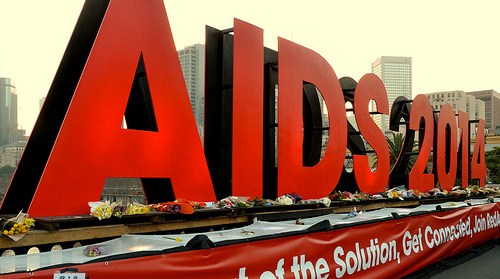
The year in HIV

PARTNER
Not long into the new year, the initial findings of the PARTNER study were released and they made for encouraging reading. The European study was set up to assess the risk of transmission between serodiscordant couples engaging in condomless sex. Unlike previous trials, the PARTNER study included a strong gay cohort.
Researchers discovered that — providing the positive partner is on treatment and maintaining a suppressed viral load — there is almost “zero risk” of HIV transmission. Full results won’t be known until 2017, but still, the interim findings are miraculous news for those of us in serodiscordant relationships and further re-enforce the treatment as prevention message.
The wait is over
From April 1, the barrier limiting treatment access for HIV-positive people with CD4 counts of 500 and above was lifted. The move followed a submission to the Pharmaceutical Benefits Advisory Committee by NAPWHA, AFAO, ASHM and the Kirby Institute after international research showed significant long-term health benefits for people living with HIV (PLHIV) who treat early.
Getting tested
The year saw a further increase in rapid testing sites across the country. These were run from GP clinics, sexual health services, community organisations and events such as Mardi Gras’ Fair Day. Successfully attracting people who had never tested before, you can expect more pop-up sites appearing in the new year.
In addition, restrictions have been lifted on home-testing kits. Already available in the US and given the go-ahead in the UK, the kits — likened to home pregnancy tests — will make HIV testing more accessible, particularly for Australians living in remote communities.
Easier access
It was also announced that — from July 1 next year — PLHIV will be able to collect their meds from community chemists (anti-HIV drugs are currently only available through hospital pharmacies).
While this will make life easier for PLHIV, the change does throw up some legitimate concerns — particularly surrounding privacy. Expect to hear much more on this subject as the deadline looms.
National Strategy
Ahead of AIDS 2014, federal Health Minister Peter Dutton unveiled the Seventh HIV National Strategy. Its core goals are to virtually eliminate HIV in Australia by 2020, reduce the morbidity and mortality caused by HIV, and to minimise the personal and social impact of the disease.
AIDS 2014
Which brings us to the 20th International AIDS Conference itself. In July, 13,600 delegates from more than 200 countries converged on Melbourne for the largest health conference ever held in Australia. Although universally deemed a huge success, the event was marred by the MH17 plane crash just days before the conference was due to begin.
Six delegates were among the 298 people killed — including former president of the International AIDS Society, Professor Joep Lange. Conference co-chair Françoise Barré-Sinoussi summed up the mood at the opening ceremony by saying: “The extent of the loss of our colleagues and friends is hard to comprehend or express.”
Key conference speakers included former US President Bill Clinton, musician and anti-poverty campaigner Bob Geldof, former High Court judge and AIDS activist Michael Kirby, and UNAIDS chief Michel Sidibé.
Sidibé called for an end to AIDS by 2030. In order to reach that goal, by 2020 90 per cent of people will need to be tested; 90 cent of PLHIV will need to be on treatment; and 90 per cent of people on treatment will need to achieve suppressed viral loads.
Remission possible
While a cure for HIV remains elusive, developments in remission science caused much excitement at AIDS 2014 (remission being when the virus is not active enough for a patient to require treatment).
To date, there have been several instances of people becoming seemingly HIV-free — the most famous case is the “Berlin patient“, Timothy Brown, who has remained virus-free for seven years. It was announced at conference that two Australian patients have also been found to be HIV-free.
However, we learned this year that other remission case studies — the Mississippi baby and the Boston patients — have since relapsed, with HIV returning to detectable levels. Even so, such examples raise hope that HIV can one day be kept at bay.
Kick and kill
Another development that created a conference buzz was news of a treatment approach dubbed “kick and kill”. Hailed as “the single most important advance” presented at AIDS 2014, researchers announced that they had found a way to expose hidden HIV in CD4 cells, thus potentially providing an opportunity to eliminate invisible reservoirs of the virus. “If you can activate all the cells and get them killed, then you have a cured person,” a senior researcher said.
Other conference highlights included the good news about next-generation hepatitis C and TB treatments; the rowdy mobilisation march; the moving candlelight vigil; and the truly international Global Village.
Section 19A
Responding to community advocacy in the lead-up to AIDS 2014, the Victorian Government announced its intention to “amend” Section 19A of the Crimes Act 1958 (the only HIV-specific law in Australia to discriminate against people living with the disease). However, now that there is a new Labor Government in Victoria, it is expected — as promised pre-election — that Section 19A will be repealed altogether.
Treatments
A new important integrase inhibitor dolutegravir (DGT, brand name Tivicay) — was approved by the Therapeutic Goods Administration (TGA) and listed on the Pharmaceutical Benefits Scheme (PBS) as an s100 drug this year. In trials, DGT was found to be extremely effective in suppressing HIV replication. The once-daily medication also has a high genetic barrier to the development of HIV resistance; as well, it has fewer side effects.
Another noteworthy treatment is Triumeq. A fixed-dose combination pill, Triumeq contains three medications — the integrase inhibitor dolutegravir (as mentioned above); and two nucleoside reverse transcriptase inhibitors: abacavir and lamivudine.
Earlier this year, the single tablet regimen was approved by both the US Food and Drug Administration (FDA), and the EC. An application for the licensing of Triumeq is currently with the TGA.
This year also saw a new “Quad” on the block. Stribild — a once-daily, four-in-one combination pill became available on the PBS on May 1. Stribild is the third single tablet regimen (STR) to become available to PLHIV in Australia.
Like the two other STRs — Atripla and Eviplera — Stribild is a highly effective antiretroviral (ARV) drug. It contains three active ARVs: a newly licensed integrase inhibitor, elvitegravir; and two nucleoside reverse transcriptase inhibitors: tenofovirand emtricitabine.
The fourth drug is a new booster, cobicistat, or COBI (which is currently being considered as an alternative to ritonavir in other HIV drug combinations and may be approved by the PBS next year). Stribild is taken with food and has been found to be well tolerated with few adverse liver effects.
PrEP
The drug that hogged the limelight this year was Truvada. Already used to treat HIV, Truvada came to prominence two years ago when the FDA approved the drug as a pre-exposure prophylaxis (PrEP).
In trial after trial, Truvada has been found to be highly effective in reducing the risk of HIV transmission. Truvada as PrEP is for people at substantial risk of HIV such as gay men, people who inject drugs, or negative partners in serodiscordant relationships.
Truvada is a single dual combination pill (tenofovir/emtricitabine) that has to be taken every day. Strict adherence is crucial to achieving a high level of protection against HIV. At least, that was the received wisdom until very recently.
But a French study — iPERGAY — may have turned that received wisdom on its head. The study was initiated to assess the efficacy of taking Truvada before and after sex — rather than daily. Results showed a “very significant” reduction in the risk of HIV infection.
The findings have been described as “the most significant breakthrough in the battle against HIV in a generation”. However, many in the HIV sector remain cautious and view Truvada as an additional method of protection alongside condoms and other safe-sex strategies.
As yet, Truvada as PrEP is not available in Australia but there are currently three trials underway in NSW, Queensland andVictoria. If the results mirror previous studies as expected, there will be urgent calls for Truvada to be licensed for use as PrEP here.
World AIDS Day
More than 170 events were held nationwide to commemorate the 26th World AIDS Day. The theme this year was “Getting to Zero” — zero new infections and zero stigma. It’s a rally cry worth remembering as we enter 2015.
This article first appeared in Positive Living.
Christopher Kelly is the editor of Positive Living, which is published by the National Association of People With HIV Australia (NAPWHA)
RELATED: YEAR IN REVIEW — The LGBTI news stories that shaped 2014









